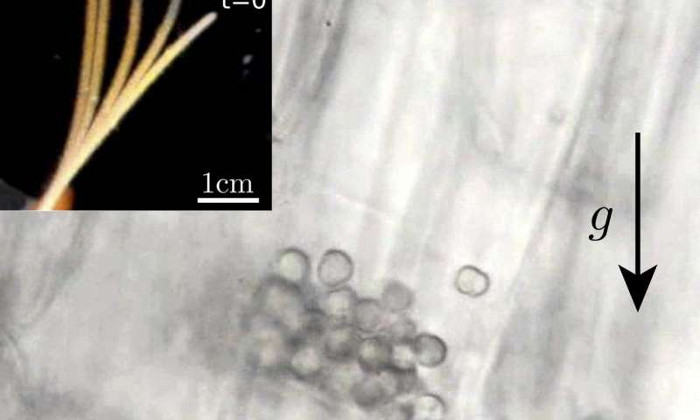Where does the plant know the direction of 'top' and 'bottom' to determine the direction of development?
French scientists have discovered that there are molecular-level motors in particles in plant cells, allowing plants to feel tilt and gravity to determine the direction of development.
According to the article published in the PNAS journal, French scientists have explained the abnormal behavior of particles in plant cells, allowing them to feel tilt and gravity. Experiments have shown that there are molecules at the molecular level that help these particles move.

Particles gravel balance statolith in wheat plants - (Photo: PNAS magazine).
In many animals (including humans), the sense of balance is ensured by the inner ear, where ear stones (eardrums) are present . When we tilt, move the ear stones under the influence of gravity stimulates sensitive hairs and we feel that our body's position has changed. This is necessary for people to move normally. Although plants do not move, they still need to feel gravity to determine what is "top" and "bottom" and choose the direction of growth. And to do this, plants have what is known as a balance stone (statolith in plant cells) , which are solid particles of matter in special cells. Stabilized statolith stones are deposited under the influence of gravity and thanks to them, plant organs can determine the direction they need to grow.
However, for a long time, science could not understand what allowed plants to feel exactly the changes in gravity and tilt. A pinch of particles or particles is an inaccurate tool for measuring inclination, because interactions between particles and friction will make the system ineffective. French biologists have discovered this secret. They first monitored the motion of each gravel particle with statolite balance in response to the inclination and found that the particles were quite different from the particle system. They flow from one place to another regardless of the angle of tilt like liquid.
But what makes balancing gravel particles act like a liquid and not stick together? To answer this question, the scientists simulated the entire system with the actual size in artificial cells that introduced micro particles. Comparing the behavior of their model with those of statolith gravel in living cells, French biologists concluded that the mobility of the mass of particles arises from the movements of individual particles. The reason that the non-stick particles and not attached to each other statolith particle is that there are molecular motors that work continuously to make them move.
Scientists plan to continue researching and understanding how plants feel the movement of gravel particles equaling statolith.
- How to determine simple directions by sun and experience
- How to determine the direction by the Moon
- How to determine the direction only through a puddle
- Ants determine direction by smell
- Bovine always turns its head in one direction
- Astronomers know how to fly
- Why do storms often follow the West-North direction?
- Inauguration of the most modern greenhouse and greenhouse in the South
- Sound sensors can identify the direction of sound and filter out noise
- Dive to the bottom of the coldest lake in the winter
- What is the bottom of the Antarctic sea?
- Detecting signs of life in the bottom of the Antarctic lake
 Why do potatoes have eyes?
Why do potatoes have eyes? 'Tragedy' the world's largest carnivorous life: Death becomes ... public toilet
'Tragedy' the world's largest carnivorous life: Death becomes ... public toilet Tomatoes were once considered 'poisonous' for 200 years
Tomatoes were once considered 'poisonous' for 200 years Detecting microscopic parasites on human face
Detecting microscopic parasites on human face